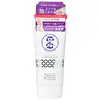What's inside
What's inside
 Key Ingredients
Key Ingredients

 Benefits
Benefits

 Concerns
Concerns

 Ingredients Side-by-side
Ingredients Side-by-side

Water
Skin ConditioningGlycerin
HumectantDipropylene Glycol
HumectantParaffinum Liquidum
EmollientDimethicone
EmollientCetearyl Alcohol
EmollientTriethylhexanoin
MaskingGlyceryl Stearate
EmollientOryza Sativa Extract
AbsorbentRetinyl Palmitate
Skin ConditioningPanthenol
Skin ConditioningTetrahexyldecyl Ascorbate
AntioxidantTocopherol
AntioxidantGlucosyl Hesperidin
HumectantArginine
MaskingAlanine
MaskingGlutamic Acid
HumectantProline
Skin ConditioningGlycine
BufferingAspartic Acid
MaskingValine
MaskingSerine
MaskingPhenylalanine
MaskingHistidine
HumectantIsoleucine
Skin ConditioningThreonine
Ceramide EOP
Skin ConditioningCeramide NP
Skin ConditioningCeramide AP
Skin ConditioningRice Ferment Lees
HumectantOryza Sativa Bran Oil
EmollientZea Mays Germ Oil
EmollientArbutin
AntioxidantDipotassium Glycyrrhizate
HumectantSqualane
EmollientArachis Hypogaea Oil
Skin ConditioningSorbitol
HumectantButylene Glycol
HumectantPEG-6
HumectantPEG-32
HumectantCholesterol
EmollientPhytosphingosine
Skin ConditioningTea-Lactate
HumectantPCA
HumectantSodium PCA
HumectantSodium Lauroyl Lactylate
EmulsifyingHydrogenated Lecithin
EmulsifyingHydroxyethylcellulose
Emulsion StabilisingCarbomer
Emulsion StabilisingXanthan Gum
EmulsifyingAcrylates/C10-30 Alkyl Acrylate Crosspolymer
Emulsion StabilisingPhytic Acid
Potassium Hydroxide
BufferingSilver Oxide
AntimicrobialMethylparaben
PreservativeWater, Glycerin, Dipropylene Glycol, Paraffinum Liquidum, Dimethicone, Cetearyl Alcohol, Triethylhexanoin, Glyceryl Stearate, Oryza Sativa Extract, Retinyl Palmitate, Panthenol, Tetrahexyldecyl Ascorbate, Tocopherol, Glucosyl Hesperidin, Arginine, Alanine, Glutamic Acid, Proline, Glycine, Aspartic Acid, Valine, Serine, Phenylalanine, Histidine, Isoleucine, Threonine, Ceramide EOP, Ceramide NP, Ceramide AP, Rice Ferment Lees, Oryza Sativa Bran Oil, Zea Mays Germ Oil, Arbutin, Dipotassium Glycyrrhizate, Squalane, Arachis Hypogaea Oil, Sorbitol, Butylene Glycol, PEG-6, PEG-32, Cholesterol, Phytosphingosine, Tea-Lactate, PCA, Sodium PCA, Sodium Lauroyl Lactylate, Hydrogenated Lecithin, Hydroxyethylcellulose, Carbomer, Xanthan Gum, Acrylates/C10-30 Alkyl Acrylate Crosspolymer, Phytic Acid, Potassium Hydroxide, Silver Oxide, Methylparaben
Urea
BufferingTocopheryl Acetate
AntioxidantWater
Skin ConditioningGlycerin
HumectantParaffinum Liquidum
EmollientCetearyl Alcohol
EmollientDipropylene Glycol
HumectantButyl Octanoate
PerfumingGlyceryl Stearate Se
EmulsifyingGlyceryl Isostearate
EmollientPEG-8 Dimethicone
EmulsifyingXylitol
HumectantStearic Acid
CleansingGlycol Stearate
EmollientAmethyst Powder
AbrasiveGlycine
BufferingPotassium Hydroxide
BufferingEthylcellulose
3-Hydroxybenzoic Acid
Skin ConditioningCI 77492
Cosmetic ColorantCI 77491
Cosmetic ColorantUrea, Tocopheryl Acetate, Water, Glycerin, Paraffinum Liquidum, Cetearyl Alcohol, Dipropylene Glycol, Butyl Octanoate, Glyceryl Stearate Se, Glyceryl Isostearate, PEG-8 Dimethicone, Xylitol, Stearic Acid, Glycol Stearate, Amethyst Powder, Glycine, Potassium Hydroxide, Ethylcellulose, 3-Hydroxybenzoic Acid, CI 77492, CI 77491
 Reviews
Reviews

Ingredients Explained
These ingredients are found in both products.
Ingredients higher up in an ingredient list are typically present in a larger amount.
Cetearyl alcohol is a mixture of two fatty alcohols: cetyl alcohol and stearyl alcohol. It is mainly used as an emulsifier. Emulsifiers help prevent the separation of oils and products. Due to its composition, it can also be used to thicken a product or help create foam.
Cetearyl alcohol is an emollient. Emollients help soothe and hydrate the skin by trapping moisture.
Studies show Cetearyl alcohol is non-toxic and non-irritating. The FDA allows products labeled "alcohol-free" to have fatty alcohols.
This ingredient is usually derived from plant oils such as palm, vegetable, or coconut oils. There is debate on whether this ingredient will cause acne.
Due to the fatty acid base, this ingredient may not be Malassezia folliculitis safe.
Learn more about Cetearyl AlcoholDipropylene Glycol is a synthetically created humectant, stabilizer, and solvent.
This ingredient helps:
Dipropylene glycol is technically an alcohol, but it belongs to the glycol family (often considered part of the ‘good’ alcohols). This means it is hydrating and gentle on skin unlike drying solvent alcohols like denatured alcohol.
As a masking agent, Dipropylene Glycol can be used to cover the smell of other ingredients. However, it does not have a scent.
Studies show Dipropylene Glycol is considered safe to use in skincare.
Learn more about Dipropylene GlycolGlycerin is already naturally found in your skin. It helps moisturize and protect your skin.
A study from 2016 found glycerin to be more effective as a humectant than AHAs and hyaluronic acid.
As a humectant, it helps the skin stay hydrated by pulling moisture to your skin. The low molecular weight of glycerin allows it to pull moisture into the deeper layers of your skin.
Hydrated skin improves your skin barrier; Your skin barrier helps protect against irritants and bacteria.
Glycerin has also been found to have antimicrobial and antiviral properties. Due to these properties, glycerin is often used in wound and burn treatments.
In cosmetics, glycerin is usually derived from plants such as soybean or palm. However, it can also be sourced from animals, such as tallow or animal fat.
This ingredient is organic, colorless, odorless, and non-toxic.
Glycerin is the name for this ingredient in American English. British English uses Glycerol/Glycerine.
Learn more about GlycerinThis ingredient is an amino acid that helps build proteins and moisturizes skin. It is already present in our skin as our bodies produce them naturally.
Glycine already plays a role in helping keep our skin moisturized as amino acids transport moisture throughout our skin.
As collagen is made up of glycine and other amino acids, it is believed glycine may help our skin produce more collagen.
Learn more about GlycineParaffinum Liquidum is also known as liquid paraffin. It is a type of highly refined mineral oil.
Like other oils, Paraffinum Liquidum has emollient properties. Emollients help soothe and soften the skin. By creating a barrier to trap moisture within, emollients help keep your skin hydrated.
Paraffinum Liquidum does not irritate the skin and is non-comedogenic.
Learn more about Paraffinum LiquidumPotassium hydroxide is commonly known as caustic potash. It is used to fix the pH of a product or as a cleaning agent in soap. In cleansers, it is used for the saponification of oils.
Sapnification is the process of creating fatty acid metal salts from triglycerides and a strong base. During this process, Potassium Hydroxide is used up and is not present in the final product.
Using high concentrations of Potassium Hydroxide have shown to irritate the skin.
Learn more about Potassium HydroxideWater. It's the most common cosmetic ingredient of all. You'll usually see it at the top of ingredient lists, meaning that it makes up the largest part of the product.
So why is it so popular? Water most often acts as a solvent - this means that it helps dissolve other ingredients into the formulation.
You'll also recognize water as that liquid we all need to stay alive. If you see this, drink a glass of water. Stay hydrated!
Learn more about Water